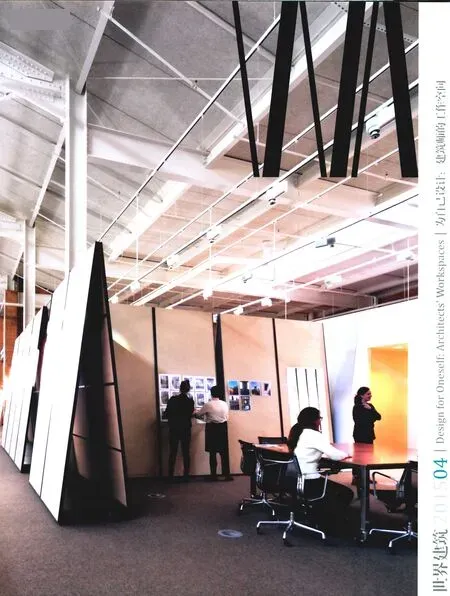埃坡卡社交中心及建筑系馆,埃坡卡大学,地拉那,阿尔巴尼亚
2015-12-19尤尔丁哈伊罗让蒂安基卡
尤尔丁·哈伊罗,让蒂安·基卡/J
埃坡卡社交中心及建筑系馆,埃坡卡大学,地拉那,阿尔巴尼亚
尤尔丁·哈伊罗,让蒂安·基卡/J

1 建筑西南方向外景/Southwest view
设计文脉
埃坡卡社交中心及建筑系馆(ESC+DA)坐落在埃坡卡大学的地拉那校区,其所在城市地拉那是阿尔巴尼亚的首都。这座建筑的设计以对校园中已经建成的建筑进行的分析为基础,以求与这些建筑建立起一种空间上的对话关系,由此反映出整个大学校园的设计理念。
功能需求
这座建筑需要容纳多种活动,这就意味着它将需要融合多种多样的空间关系。除了容纳这座大学规模最为庞大的院系之外,这座建筑还需设置会议大厅、咖啡厅、小卖部、学生社交俱乐部以及图书馆这一系列满足大学社交需求的空间。为了更好地容纳这些功能并整合它们之间复杂的空间关系,这座建筑从对建筑元素的透明叠加为起点进行了设计。
空间组织
建筑系的学生是这座建筑的使用者群体之一,ESC+DA希望能够通过其空间组织和室内设计上的创新为学生们的建筑学教育提供一个触手可及的实例。在这座建筑中,每一个空间和体量都能够清晰地体现自身特质,而建筑中的实体结构和材料则进一步强调了这些特质。这样的设计手法使得学生们可以清楚地感知建筑物的建造过程,而使这座建筑本身也成为了建筑学习的一个对象。
用来定义空间的建筑元素和支撑建筑功能的设备系统都成为了一个透明网络的一部分。构成建筑实体的一系列部件的设计都采用了一种独特的教学性手法来进行。通过对相应材料的精确运用和对空间的精准定义,柱子、墙体、窗户、地板和天花板这些线状或面状的建筑元素逐渐在建筑中显现出来。在这样的设计原则下,材料的精髓得以在建筑中体现,进而影响其所定义的空间。
这座建筑的目的在于通过多种建造手法来刺激学生对于空间的感知力。构成展示墙体的砖块,在具有三维视幻效果的地板制作中采用的大理石,通透空间中采用的玻璃,栏杆的框架所使用的钢材,以及实现了建筑设备和电力系统在建筑空间内呈半露出状态的金属板、石膏与木质天花板,这些材料之间的和谐关系及在被使用过程中自身意义的显现都是能够激发学生灵感的。
从结果上来说,这座建筑通过同时整合多种功能、材料来从细节上对空间进行表达,由此使其自身成为了一个永远开放的讲座。
建筑作为一种将形态赋予物质的工具,成为了一种触手可及的教育媒介。(李璠 译)

2 建筑西北方向外景/Northwest view

3 三层平面/Floor 2 plan

4 二层平面/Floor 1 plan

5 首层平面/Floor 0 plan

6 剖面/Section

7 建筑东北方向外景/Northeast view
The Context
The Epoka Social Center and Department of Architecture (ESC+DA) building is part of the Epoka University Campus in Tirana, capital of Albania. The ESC+DA building is both a product of analysis derived from the spatial dialogue with the existing campus buildings and a reflection of its major design strategy.
The content
the building was commissioned to accommodate a variety of activities requiring an amalgam of spatial relations. While it hosts the university's most expansive department, other facilities such as the conference hall, the cafeteria and the canteen, the student clubs and the library respond to the university's social spatial needs. To better accommodate their complex functional relationships and reformulated program, the design was based on the transparent fabrication of the architectural idea.
The fabrication of space
Designed to serve the architecture students, among others, through spatial composition and interior design principles, ESC+DA aims to play a didactic role in their architectural education. Space and volume were given substantial emphasis so that each could express its character and present its typology. This approach allows the students to clearly perceive the building processe, and so was practically incorporated in their architectural curriculum.
the space-defining elements and the infrastructural system of the building become part of a transparent network. The components of what a building is made of are uniquely designed with a pedagogical approach. The composition of linear and planar elements like the columns, walls or windows, floors and ceilings is conveyed through the essential use of the materials they are made of, and through the particular space they define. In this framework, the essence of each material, together with the effects on the space it defines, is clearly expressed.
the aim is to stimulate the students’ perception through various architectural tools. The project aspired to achieve a harmony between the materialization of construction elements and the embodiment of their meanings, such as the brick in the exhibiting/exhibited walls, the marble in the illusive three-dimensional flooring, the glass in the penetrable depth of space, the steel in the framed linearity of the railings, the metal sheet, gypsum and wood ceiling that constitute the semi-presence of the mechanical and electrical infrastructure.
In this way the transparency of the structural, mechanical, and electrical engineering systems of the building acts as an educational instrument for all students.
Consequently, the whole ensemble manifests and produces details through the implementation of various projects and materials, making the building function as a permanent open lecture.
Architecture as a form-generating tool becomes a pedagogical agent for our environment, in the service of education.

8 教室墙壁/Classroom wall

9 教室墙壁大样/Classroom walls

10 办公室/Office wall

11 办公室墙壁大样/Office walls

12 建筑工作室内景/Interior of arch studio

13 工作室墙壁大样/Studio walls
项目信息/Credits and Data
概念与建筑设计/Concept and Building Design
建筑事务所/Architecture Studio: Zambak建筑事务所/ Zambak Architects, Istanbul
建筑团队/Design Team: Jurtin Hajro, Kadir Karakoç, Mesut Dural
设计时间/Design Period: 2012.05–2012.09
室内设计/Interior Design
建筑事务所/Architecture Studio: 埃坡卡大学建筑研究设计中心/Center of Research and Design in Architecture, Epoka University (CoRDA), Tirana
设计团队/Design Team: Jurtin Hajro, Gentian Kica
设计时间/Design Period: 2013.01–2013.08
致谢/Acknowledgement: José Ramon Fermin, Emre Can Y1lmaz, Kamil Gürbüz, Artan Hysa, Valbona Koçi and Sokol Dervishi
建造时间/Construction Period: 2012.09-2013.10
建筑面积/Floor Area: 6987m2
摄影/Photos: Eduard Pagria (Fig 1,15), CoRDA (Fig 2,7,10, 14,16,17), Elis Vathi (Fig 8)
Epoka Social Center and Department of Architecture Building, Epoka University, Tirana, Albania, 2013
urtin Hajro, Gentian Kica

14 展廊/Gallery

15 首层楼梯及大厅/Ground floor staircase and hall

16 展廊/Gallery

17 办公室/Offices
